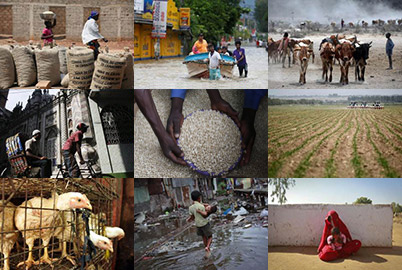Jude-Marie Banatte features in One Day in Port-au-Prince, a multimedia documentary.
PORT-AU-PRINCE (AlertNet) - It's hard to imagine a more thorough job of destruction than the quake's demolition of the St. Francois de Sales hospital in downtown Port-au-Prince.
The few remaining walls enclose a roiling heap of concrete, iron and every kind of detritus. Here and there are reminders that this was once a functioning clinic: a smashed sink, a broken bed, medical machinery crushed beyond recognition.
Almost a year after the earthquake, the rubble still entombs the bodies of patients who were there when the hospital collapsed at 4.53 p.m. on Jan. 12, 2010.
“As you can see, just behind me, we have a 70 to 80 percent destroyed facility,” said Jude-Marie Banatte.
He was standing on the roof of the main building, with the Kenscoff mountains in the distance. “I knew what this used to look like before, and I got here and I said: ‘Oh wow, there’s nothing left.”
Jude-Marie is a doctor working for aid agency Catholic Relief Services, which ran the hospital before the disaster. When the 7.0-magnitude earthquake hit, he was in Les Cayes, on Haiti’s southwestern coast.
He rushed to Port-au-Prince, but with the roads choked with traffic, debris and hundreds of thousands of the newly homeless, it took him two days to reach St. Francois de Sales.
“After 48 hours, you can imagine the corpses that were still under the rubble, not smelling good, a lot of flies… I saw a lot of people, some who I might know…”
One of the defining characteristics of Haiti’s catastrophe was that many of the services that people desperately needed in the aftermath were themselves destroyed. Police, Red Cross, United
Nations, hospitals - all were severely affected. Even the helpers needed help.
In the ruins of St. Francois de Sales, Jude-Marie saw dozens of trauma cases, people who would die without quick attention. And more and more injured people were coming in off the streets. He decided to salvage what he could from the wreckage to improvise an outdoor operating theatre.
“I was the handy man, moving things,” he recalled. “I was helping to dig tunnels to get access and go and see what was still usable.”
Not much was.
“No lab, no X-ray, no operating room, no staff, no power lines. How can we get a hospital back in operation in that context? But on the other hand, we had 40 patients not knowing where to go, needing to be saved. Lives needed to be saved.”
He ferreted everywhere, crawling through a precarious-looking tunnel to scavenge half-working equipment from the bowels of the building. In the parking lot, colleagues hung plastic sheets on trees to shelter patients from the sun.
“We managed at some point to have the X-ray working again, so the doctors could have better diagnosis,” Jude-Marie said. “We also managed to have running water, which is so critical to have a medical facility work. We also managed to get waste disposal.”
With jerry-rigged generators and makeshift tools, they operated for five days straight, amputating legs and arms, setting broken bones and trying to keep wounds sterile.
“The most important thing you are pursuing is saving the life of the patient,” he said. “You could have had very nice surgery, but an infection just kills your patient.”
Under the circumstances, the success rate was amazing.
“Fortunately, we managed to save the lives of 38 of them,” Jude-Marie said.

